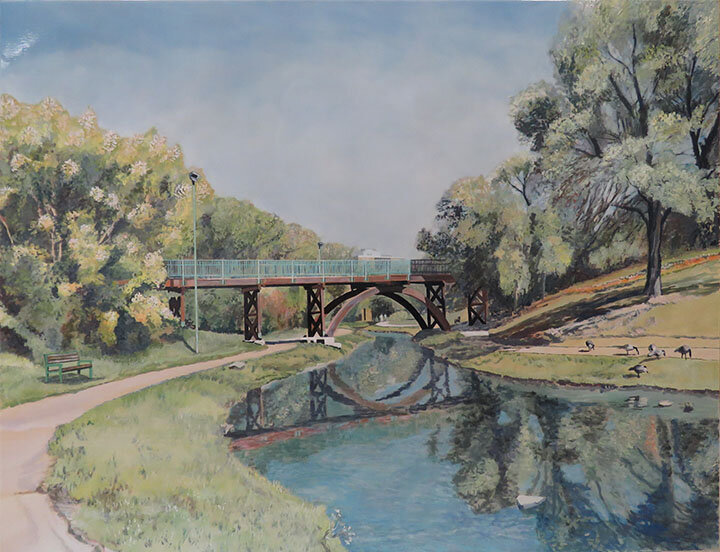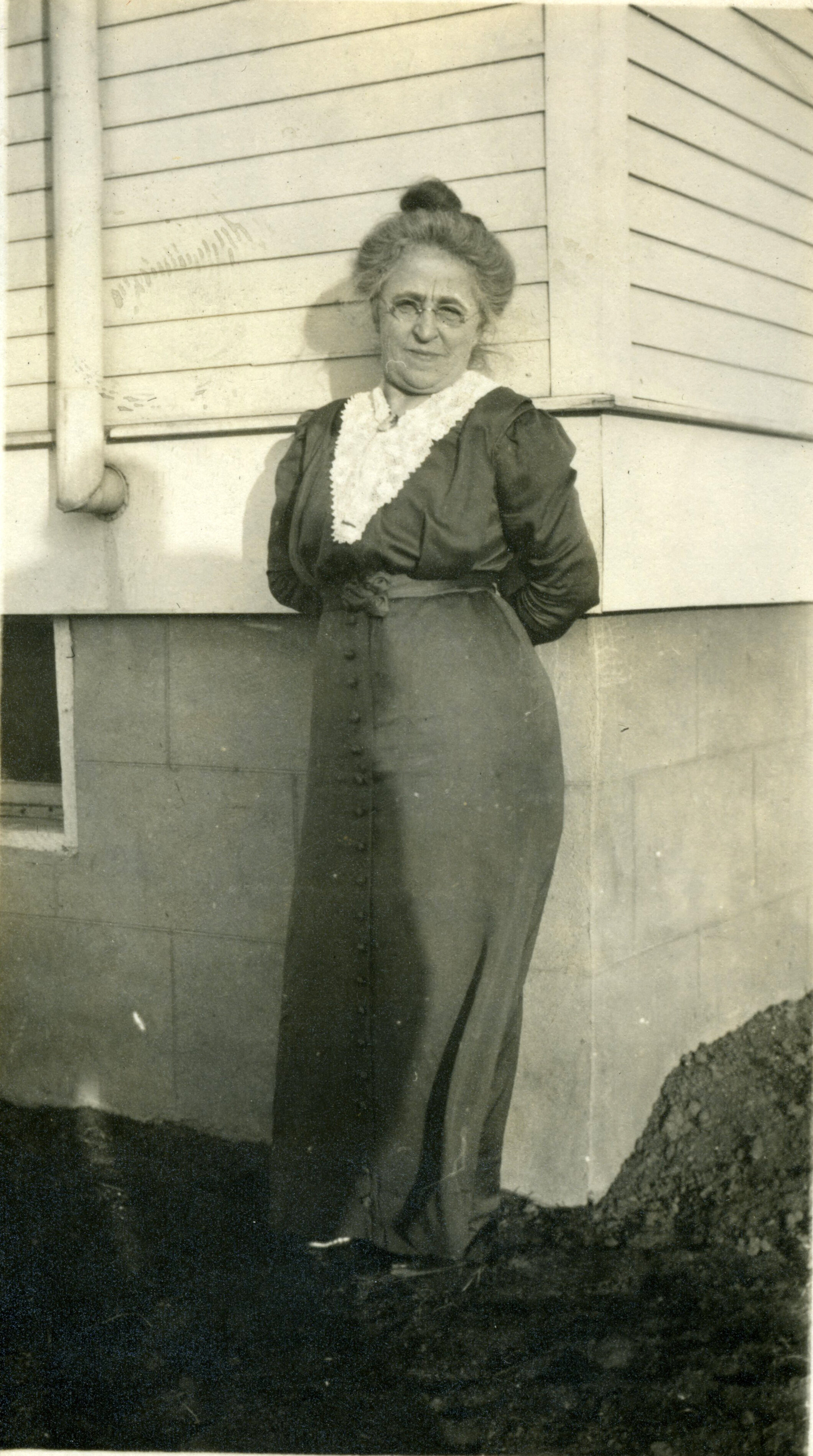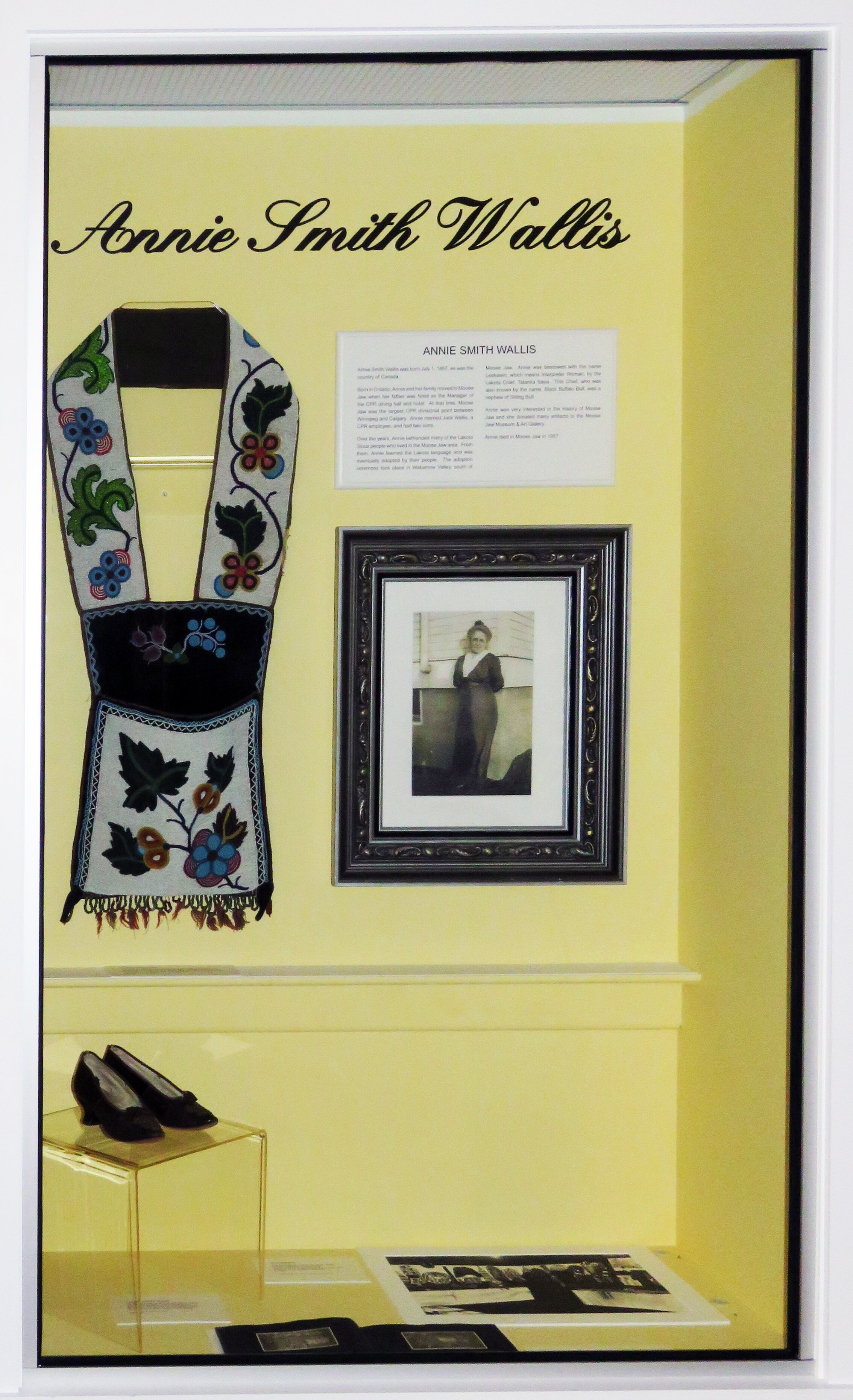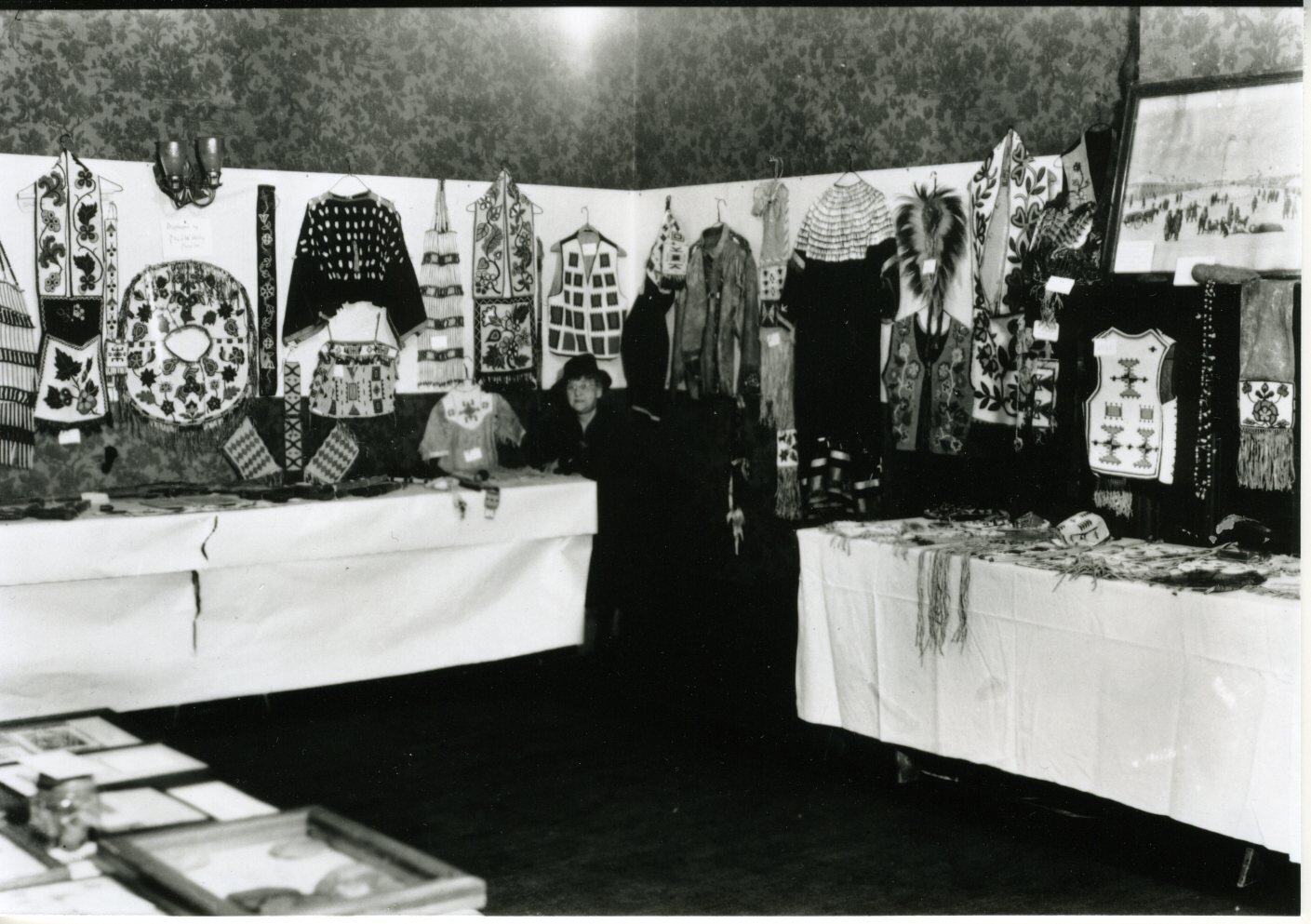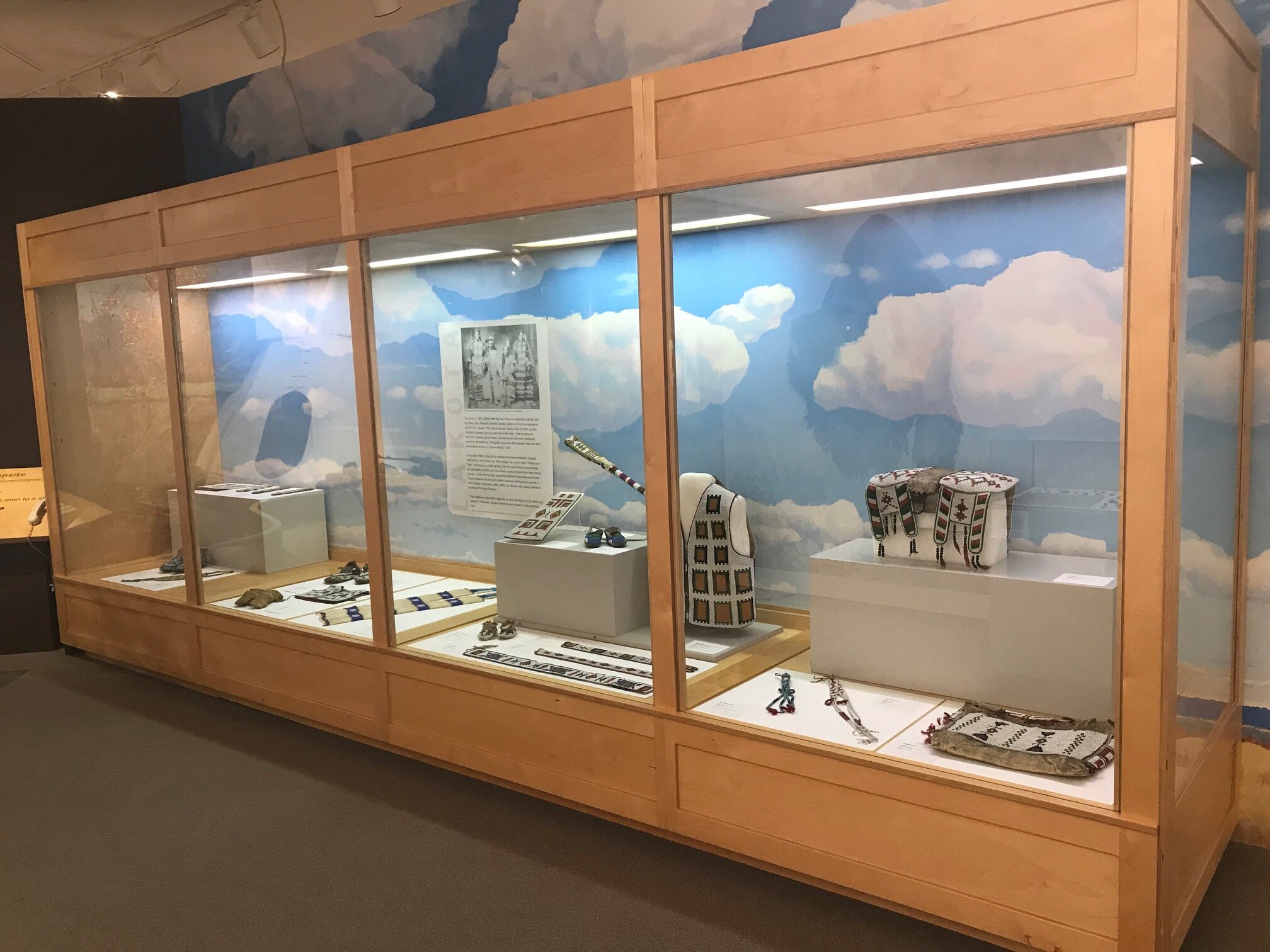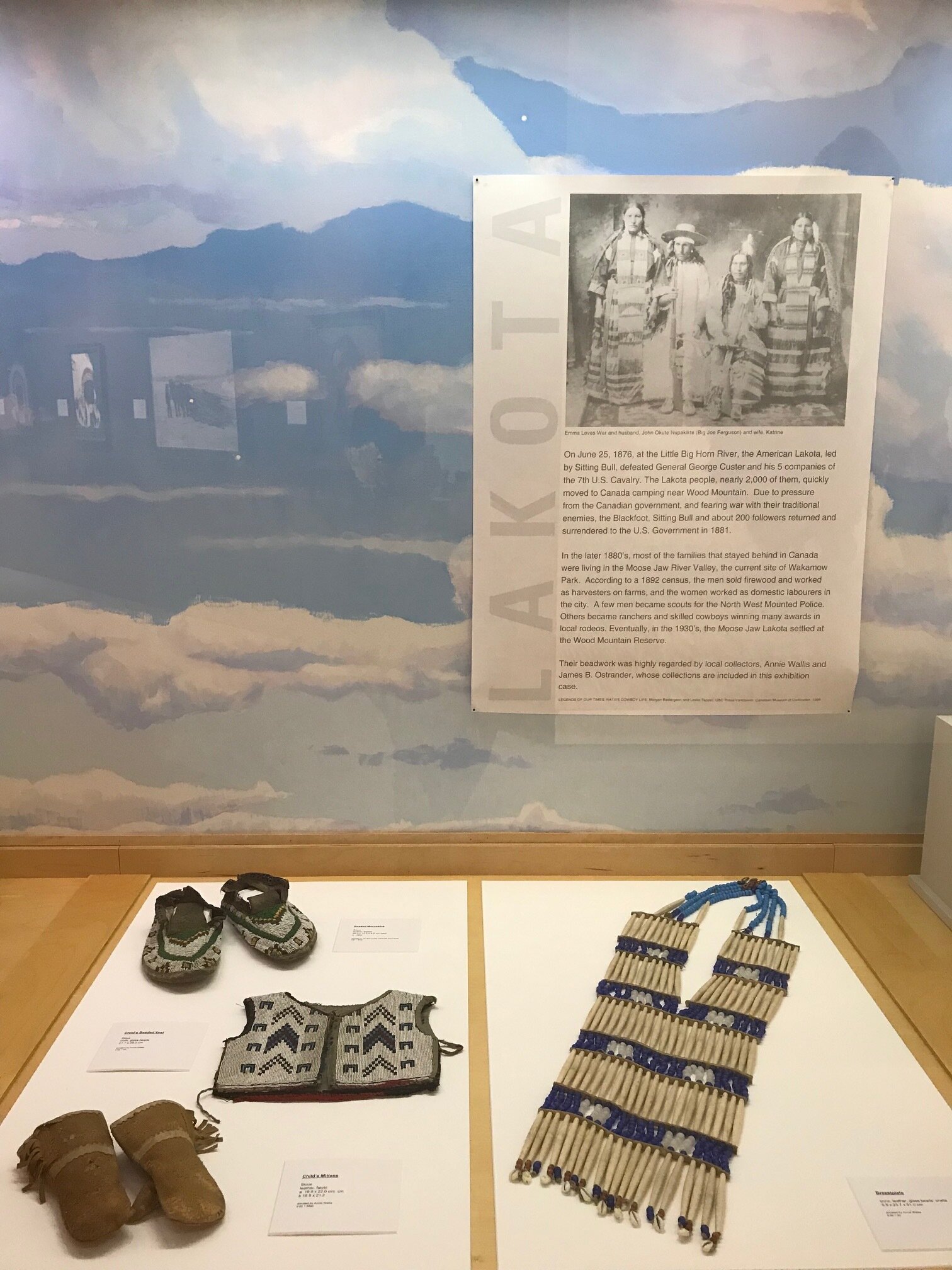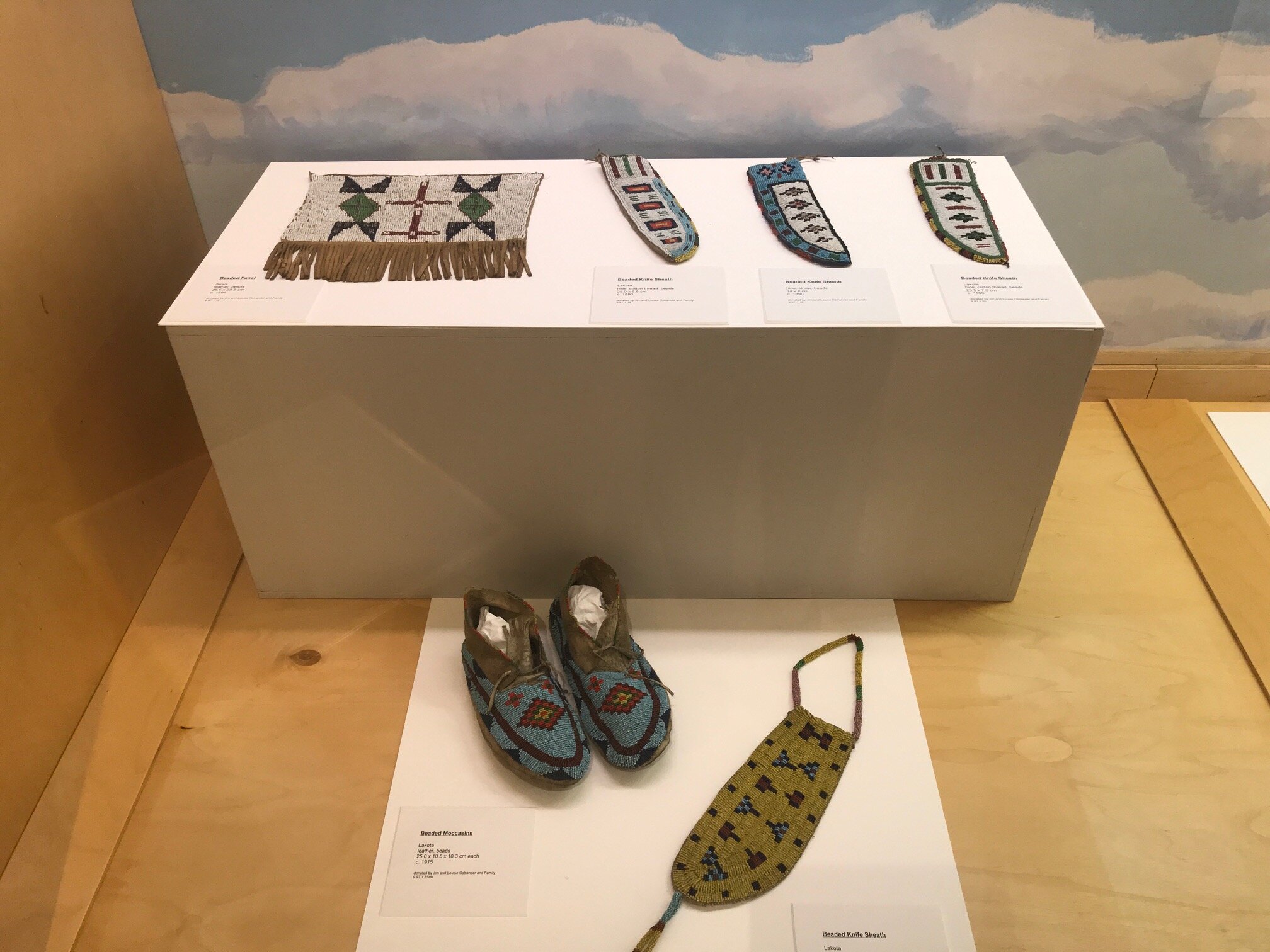FEATURES FROM THE COLLECTION #10: Carolyn Meili
In continuing our focus on youth this week, MJM&AG is featuring a photographic, light box work by Carolyn Meili in our collection that references family or childhood memories.
Read More
This work was featured in an exhibition, Joy Continues, in 2002 at the MJM&AG, where Meili created a series of photographic works culled from her grandmother’s slide images. The artist’s grandmother, Phyllis Meili, began taking slides upon retiring from the family farm and moving to Moose Jaw, where she documented her home, travels, family, and friends. Through sourcing and then slicing, cropping, enlarging, and layering the photographic images, Carolyn highlights the relationships suggested in the original slide images and yet undermines the notion of the “captured moment” in photography. Curator Heather Smith stated, “Much has been written about how photographs stop time and capture and make meaningful a specific moment. Carolyn attempts to defy these notions about photography and wishes to point out that despite our attempts to fix out experiences in time, our perceptions of the past … our memories change with our understanding and experiences over time. This body of work brings together the seemingly diverse perspectives of the retired farmer’s wife and the emerging artist into a shared language of photographs and fairy tales.”
Meili explained that, “Beyond my personal interest in the images, these photographs transcend their function as a documentation of a specific person, place, or situation to represent ‘models’ typifying culturally shared experiences. By utilizing social conventions and familiar icons, the artwork functions on both personal and communal levels for the audience.”
Now based in Ontario, Meili is recognized as an artist, curator and arts management professional. She has a Bachelor of Fine Arts degree from the Nova Scotia College of Art and Design and a Master of Fine Arts degree from the University of Saskatchewan.
FEATURES FROM THE COLLECTION #9: Heather Cline
This week we are highlighting pieces from the MJM&AG/ City of Moose Jaw Collection about Crescent Park.
Read More
Today we feature artwork that is inspired by the Park. Heather Cline, Meeting Places, 2017 - acrylic on panel – 91.4 x 121.9 cm, Collection of the MJM&AG
Heather M. Cline’s series of paintings and new media works, entitled Quiet Stories from Canadian Places, was a national touring exhibition in 2017 in response to Canada’s 150th anniversary celebrations. It was presented at the MJM&AG, and explored shifting the traditional role that painting has played in documenting history from official portraiture and pivotal historical moments to documenting Canadian places that are significant to everyday people and simple moments. Over the past 10 years, Cline has been quietly gathering stories in communities across Canada, collecting personal and regional history. Through a series of artist residencies, projects, and public engagements, she engaged individuals to share and record their personal memories of their home and community. The interviews inspired Cline to paint different geographical locations, connecting with the subject matter through other people’s reminiscences and experiences of place. Cline painted an image of Crescent Park in response to a story of the LGBTQ2+ history in Moose Jaw by Joe Wickenhauser.
Heather Cline is a painter and mixed media artist based in Regina, Saskatchewan. Since completing her MFA at the University of Saskatchewan in 2001, Cline has been exploring narratives around place and personal history. Over the past 10 years, Cline has been involved in a series of residency programs and public engagement across Canada. Her activities have included setting up a ‘Story Collection’ office from an inner city store front in Oshawa, Ontario, and riding along on combines in rural Manitoba. Cline is fascinated by how personal history intersects with human geography; currently this involves merging collage soundscapes with lush, intricate paintings of everyday places. She has participated in multiple group exhibitions, with solo exhibitions at the Robert McLaughlin Gallery (Oshawa, ON), the Mendel Art Gallery in Saskatoon, and regional exhibition centers throughout Saskatchewan. Cline’s work can be found in many public and private collections, including the Colart Collection, the Mendel Art Gallery and the Saskatchewan Legislative Building. Cline has a keen interest in community engagement and art education. In 2014 Cline received the Saskatchewan Lieutenant Governor’s Arts Award: Arts & Learning for her work as the Artist Manager of an innovative distance learning ‘Artist in the School’ program. Currently, Cline is an instructor at the University of Regina. You can view some of Cline’s art work and community projects at heathercline.ca Cline is represented by Slate Fine Art Gallery in Regina and The Gallery/Art Placement in Saskatoon.
FEATURES FROM THE COLLECTION #8: The Lakota Beadwork Collection
Lakota Beadwork at the Moose Jaw Museum & Art Gallery
Read More
1) The Annie Wallace Collection
After the battle of the Little Big Horn in 1876, some of the Lakota people that followed Sitting Bull eventually settled near Moose Jaw. A young local resident, Annie Wallis, developed close friendships among the Lakota people and received beadwork and other articles as gifts over the years. From them, Annie learned the Lakota language and was eventually adopted by their people. The adoption ceremony took place in Wakamow Valley, south of Moose Jaw. Annie was bestowed with the name Leskawin, which means Interpreter Woman, by the Lakota Chief, Tatanka Sapa. This Chief, who was also known by the name, Black Buffalo Bull, was a nephew of Sitting Bull. Interested in contributing to the history of Moose Jaw, Annie Wallis donated many of the living objects she was gifted, including an impressive collection of beaded works, to the Moose Jaw Museum & Art Gallery.
2) The Ostrander Collection
James B. Ostrander was one of the earliest settlers in the Moose Jaw area, homesteading on the site of Tatawaw Park in the Moose Jaw River Valley. Many of these artifacts were collected from the Indigenous people in this area with whom James traded horses and furs in exchange for supplies. James’ wife, Sara Elizabeth (known as Libby) Ostrander, owned and operated the first Brunswick Hotel in Moose Jaw. She employed many First Nations women to help with the work of running the hotel and to care for her young son, Percy.
James B. and Libby Ostrander passed the collection on to their son, Percy Ostrander. As a young man, Percy worked with First Nations people in various business ventures in Moose Jaw. Over the years many of these artifacts were given in friendship. Some of the pieces also came from Percy’s good friend Annie Wallis, whose extensive collection is also in this Museum. In 1917, Percy purchased the old Turkey Track Ranch near Hallonquist, southwest of Moose Jaw.
Percy Ostrander passed on the collection and the Ranch to his son James Ostrander in 1971. He and his wife Louise placed this collection on permanent loan with the Moose Jaw Art Museum in 1997, so that it could be properly stored and shared with the public. In January 2005, the Ostranders decided to permanently donate half of these artifacts to the Moose Jaw Museum & Art Gallery with the intention of donating the other half over the next few years. The historic Turkey Track Ranch is now being operated by the next generation of Ostranders.
The dates and cultural attributions on these labels were determined by Sydney A. Dobson, a Lumsden, SK-based appraiser of First Nations artifacts. If anyone viewing this exhibition has information or expertise on the attribution of this material please send us a note so we can add your information to the catalogue cards.
FEATURES FROM THE COLLECTION #7: Catherine Blackburn
This week we are highlighting beaded works from the MJM&AG / City of Moose Jaw collection, featuring the work of Saskatchewan-born, contemporary artist, Catherine Blackburn.
Read More
We have 3 works in our collection by Blackburn, which are recent acquisitions from 2018 and 2019. Catherine Blackburn is a contemporary Saskatchewan artist, born in Île-à-la-Crosse, Saskatchewan, of Dene and European ancestry, and is a member of the English River First Nation. She grew up in the small rural town of Choiceland, Saskatchewan and holds a BFA from the University of Saskatchewan. Blackburn’s work embraces two inspirations in her life - family and culture. Through the subject of family, she is inspired to express her own feelings and experiences which speak to the complexities of memory, history and cultural identity. Her art merges contemporary concepts with elements of traditional Dene culture, simultaneously exploring the significance and history of certain materials and their role in the fur trade. This direct relationship to her European and Dene heritage challenges her to create innovative work that encourages dialogue between traditional art forms and new interpretations of them. Through these overlapping themes of relationships, history, and identity, she hopes to weave a strong message of connection, kinship, and resiliency.
The Cradleboard piece is currently touring Saskatchewan in the exhibition, New Age Warriors, curated by Jesse Campbell and organized by the Mann Art Gallery. Campbell explains that in this exhibition, “Catherine Blackburn melds traditional form with contemporary design in New Age Warriors, using the framework of beading to explore cultural identity, memory, and history. As a jeweler and visual artist, Catherine has worked in painting, quilling, and beading to address Canada’s colonial past through her personal experiences. An exploration of new media and directions in her practice, Catherine has fashioned warrior garments and language medallions from plastic Perler beads in New Age Warriors to show the connection between materiality and Indigenous women’s ability to adapt to their changing environments. Each outfit is an amalgamation of elements in female clothing from different North American nations, honouring the diversity and innovation of traditional Indigenous design.”
“Asserting the importance of language characterizes much of the work in Catherine’s practice, and this continues in New Age Warriors. For example, the terms “mother” and “my mother” are beaded in Cree syllabics (on both the cradleboard and medallion, in a graffiti style) and Dene syllabics, respectively, in addition to universal sign language. These pieces underscore identity of the mother within Indigenous culture and of the women that inspired Catherine to create this body of work. The incorporation of words also reminds us that loss of language through colonialism has been destructive to First Nations throughout Canada. Language gives power and meaning, just as women have created environments of love and support in Indigenous heritage.”
FEATURES FROM THE COLLECTION #6: Eva & Wesley Dennis
Continuing to highlight works from the MJM&AG / City of Moose Jaw collection that are included in the touring exhibition A Prairie Vernacular, this feature focuses on the work of Eva and Wesley Dennis.
Read More
The Dennises were active in the arts community in Moose Jaw, and their work became respected throughout Saskatchewan for its authentic drive to record the settler history of our province.
Eva Dennis (née House) was born in Gravenhurst, Ontario and moved to Moose Jaw, SK in 1912, with her family. She went to Teacher’s College in the 1920s and taught at rural schools until retirement in 1965. In 1932, she married fellow artist, Wesley Dennis, and in 1973, the Dennises moved to Brownlee, SK. She began to paint in the 1950s, experimenting with tubes of paint her husband, Wesley, had discarded. Eva painted numerous scenes from her childhood, and also memories of when she was a teacher. Her paintings soon became known as a visual documentation of a past lifestyle in the Prairies.
She joined the Moose Jaw Fine Arts Guild and showed her work annually in their exhibitions at the Moose Jaw Museum & Art Gallery. After being accepted into a Saskatchewan Arts Board Annual Show, Eva continued to exhibit in many solo and group exhibitions across Saskatchewan. She often exhibited together with her husband, Wesley.
Wesley was born in Wyoming, Ontario and moved with his family to Saskatchewan when he was one year old. He grew up in Moose Jaw, SK and later began farming just south of Moose Jaw. Wes painted and sketched at an early age: drawing at four, painting in watercolours at nine, and taking up oils at fifteen. Although he didn’t have any formal art training, he educated himself by reading numerous books on art and was well acquainted with famous Canadian artists. Tom Thomson and Emily Carr are two of these artists that influenced his approach to Saskatchewan landscape painting.
Wes was a member of the Moose Jaw Fine Art Guild and held the offices of Vice-President and President. Drawing on his life and memories, he became an accomplished painter, together with his wife, Eva, and they both focused on depicting rural Saskatchewan from pioneer days to the 1980s. Upon his retirement from farming In 1973, Wes and Eva moved to Brownlee, SK where he painted full time.
Highly respected as significant Saskatchewan folk artists, the Mendel Art Gallery presented a retrospective exhibition of their work in 1994, titled Wesley and Eva Dennis: A Shared History and curated by Dan Ring. Both Wes and Eva have work in the collections of the Canadian Museum of History, MacKenzie Art Gallery, The Mendel Art Gallery Collection at the Remai Modern, Saskatchewan Arts Board, and the Moose Jaw Museum & Art Gallery.
FEATURES FROM THE COLLECTION #5: Wendy Parsons
This feature from the MJM&AG / City of Moose Jaw Permanent Collection is a work by Moose Jaw artist Wendy Parsons, which is also touring in the exhibition A Prairie Vernacular.
Read More
This work is part of a significant collection of ceramic works in our collection..
Wendy Parsons for nearly 40 years has been a practicing clay artist in an established studio and gallery with her partner, Zach Dietrich. She originally came to Moose Jaw as the Saskatchewan Arts Board funded Artist in Residence, and went on to become the Education Coordinator for the Moose Jaw Museum & Art Gallery, where she worked until 2002. She has been a Sessional Lecturer at the University of Regina and the Visual Arts Coordinator for the Organization of Saskatchewan Arts Councils. Her work is in numerous public and private collections and she has served on many art-related boards and juries.
Wendy Parsons studied ceramics at the University of Regina in the 1970s, where she was a student of Jack Sures, Vic Cicansky, Joe Fafard and David Gilhooly, and therefore, was influenced by the Regina Clay movement, which embraced the ideology of California Funk, incorporating humour and playfulness into her explorations of clay and in reflecting Prairie narratives.
“For many years, Wendy Parsons has created clay figures of animals that, despite their small size, have been incredibly adept at capturing their particular personality traits. Soft clay moulds incredibly well to form the folds of skin on an old Basset Hound or the curly hair of a sheep. In the 1980's, Wendy made a series of clay murals that depicted barnyard scenes complete with a whole cast of animal characters, which she says were nostalgic for her small town upbringing. Recently revisiting this subject, she began working again with the images of animals in a scene within the circular form. This time, however, she began by interviewing people who live and work with animals in an attempt to make pieces that depict specific people or stories. Influenced by a talk by David Suzuki she heard on the radio (in which the idea that perhaps our aloofness from where our food comes from, and moving away from our rural past and our connectedness and interdependence on animals, may be to depriving ourselves of some essential need), she decided to make these new round tile murals with the idea that there is something of essential importance in the stewardship of animals. The result is a series of roundels that reflect the changing reality of life in Saskatchewan.” - Quote from Heather Smith, curator of Wendy Parsons: The Rural Roundel
FEATURES FROM THE COLLECTION #4: William McCargar and David Thauberger
This feature from the MJM&AG Permanent Collection showcases two works that are currently touring the Prairie provinces in the exhibition, A Prairie Vernacular, by artists William McCargar, from Moose Jaw, and David Thauberger from Regina.
Read More
Highly regarded folk - or vernacular - artist, William McCargar, was born in 1906 in Newcastle, ON and grew up in Moose Jaw. A self-taught artist, he worked for many years for the Canadian Pacific Railway in Balgonie, SK. He started painting in 1958, and had his first exhibition entitled Windmills, Wagons and Railroads at the Dunlop Art Gallery in 1973. He passed away in 1980. McCargar painted images of rural Saskatchewan, capturing those quintessential prairie icons: grain elevators, trains, telephone poles, and fences. His work is found in a number of private and public collections, including the Canadian Museum of History, MacKenzie Art Gallery, Remai Modern, the Saskatchewan Arts Board, the University of Saskatchewan, and the Moose Jaw Museum & Art Gallery.
David Thauberger’s lenticular light box, Prairie Sentinel/Winter Sentinel, depicting a grain elevator that transitions from day to night and summer to winter, is an homage to William McCargar. McCargar was known for repeatedly depicting this subject matter with the same perspective at difference times of day and in different seasons.
These works speak to Saskatchewan’s long and robust history with vernacular art. Folk or vernacular art has been extremely prevalent here, perhaps stemming from broad shows of support from curators, contemporary artists, art dealers, collectors and the general public, which spurred vernacular artists on to continue making and showing their work. Interest in vernacular art in Saskatchewan dates back to the 1950s, when it was beginning to be collected, exhibited, and written about. Nancy Tousley states in her essay in Welcome to Our World, “Of all the provinces in Western Canada, Saskatchewan has the largest number of known self-taught artists, the longest record of exhibiting their work and according them solo shows, and the community with the most complex interactions between untrained and trained artists, who accept the former as colleagues.”i. It is this connection between untrained and trained artists in Saskatchewan and their artistic exchange that is unique and became a compelling point of curatorial inquiry for the exhibition, A Prairie Vernacular.
With a shared belief in the values of Prairie experience and history, Regina artists – David Thauberger, Joe Fafard, Vic Cicansky and Russell Yuristy - recognized that their work and motivations had a natural affinity with that of vernacular artists. Vernacular artists’ prevalence and precedence of making work about life on the Prairies provided the Regina artists with another model or context to respond to their own experience within mainstream contemporary art. Thauberger discovered folk art when he returned to Saskatchewan from graduate school and began working at the Saskatchewan Arts Board with its Permanent Collection. He recalls coming across a painting by William McCargar, titled Sun’s Glorious Set, and thinking that it was the ugliest painting he had ever seen. The painting stayed with him for days afterwards, capturing his curiosity, so he hung it over his desk to live with and unravel it. While at the Arts Board, Thauberger was invited to adjudicate works at the annual Watrous Art Salon in Watrous, Saskatchewan, where he was introduced to the work of Molly Lenhardt, Laura Harness, Harvey McInnes and Wesley & Eva Dennis, among others. His intrigue with folk art led him to search out many vernacular artists to engage with, including William McCargar, and he, along with Cicansky and Fafard, began to form relationships with many of Saskatchewan’s now-recognized folk artists, supporting their practices by collecting their works, curating work into exhibitions, as well as collaborating with them.ii. In 1976, Thauberger assisted with organizing an exhibition, Grassroots Saskatchewan, for the Norman MacKenzie Art Gallery, featuring the works of sixteen Saskatchewan vernacular artists. That same year, Fafard, Yuristy, Thauberger and Cicansky were commissioned by the provincial government, to collaborate on a project for the Montreal Olympics with vernacular artists Frank Cicansky, Molly Lenhardt, Ann Harbuz, William McCargar, Linda Olafson, Harvey McInnes and Julienne Fafard, creating The Grain Bin, a whimsical Prairie diorama created out of a full-size, wooden grain bin.iii.
There have been many contributing factors in Saskatchewan that have provided fertile ground for the historic and continuing interest in vernacular art, which is significant to the art history and the contemporary art of this province. But none of these factors have been as pervasive or compelling as the sense of community and artistic exchange that developed between its vernacular artists and artists David Thauberger, Victor Cicansky, Joe Fafard and Russell Yuristy, whose contemporary works have drawn from vernacular sources to embrace the histories, memories, humour and sensibilities of the Prairies.
i. Nancy Tousley, A Dream of More, Welcome to Our World (Kleinburg: McMichael Canadian Art Collection, 1996), p.44.
ii. From an interview with David Thauberger on March 26, 2019.
iii. The Grain Bin project was included In artscanada’s October/November issue, Prairie Folk Art, in 1979, featured as part of two articles, Making a Home Out of Existence: Nine Prairie Folk Artists and A Comprehensible World: The Work of Cicansky, Thauberger, Yuristy and Fafard, highlighting the prominent vernacular artists in Saskatchewan and their artistic exchange with these contemporary artists.
FEATURES FROM THE COLLECTION #3: Gus Froese
Moose Jaw artist, Gus Froese, spearheaded and oversaw the design and creation of this mural as a collective project with many participating artists in our community.
Read More
The resulting mural was exhibited in the Moose Jaw Union Hospital until its closure in 2015. The mural contains a collage of seven elements that depicts the early history of the medical field in Moose Jaw. From the left; there is a depiction of a traditional prairie scene prior to the establishment of Moose Jaw. The second scene is of the Moose Hotel which was used as the first hospital, depicting wounded soldiers from the North-West rebellion and Anglican nurses with the first doctor in the province. The middle scene depicts a past wing of the Moose Jaw General Hospital. The final Scene shows part of the original General Hospital facilities and nurses. This mural was donated to the MJM&AG/City of Moose Jaw Permanent Collection by the Moose Jaw Health Foundation. Plans are to display this mural as part of an upcoming museum exhibit on the history of hospitals in Moose Jaw.
FEATURES FROM THE COLLECTION #2: Cliff Eyland
The MJM&AG is honoured to have this impressive work by this renowned Canadian artist hanging in our facility, sharing it with the Moose Jaw Public Library.
Read More
Winnipeg artist Cliff Eyland has always been interested in conceptual art strategies that embrace elements of language, process and chance operations. In the 1980s, he became known for a practice of inserting artworks in books and card catalogues in libraries, to allow people to happen upon art in - what he deems to be - society’s most democratic space. Since then he has embraced the dimensions of the index card (3 x 5” or 7.6 x 12.7 cm) and has continued to place his work in libraries in large-scale installations, including the public libraries in Halifax, Edmonton, Winnipeg and now in Moose Jaw, in the perfect location between the Moose Jaw Public Library and the Moose Jaw Museum & Art Gallery. Known as the Moose Jaw Series of his book paintings, these 300 artworks are each individually titled. Check out the wonderfully playful titles here.
Cliff Eyland is a painter, writer and a curator. He studied at Holland College, Mount Allison University, and the Nova Scotia College of Art and Design. Since 1981, he has made paintings, drawings, and notes in an index card format -- 3" x 5" (7.6 x 12.7 cm).
Eyland has shown his work in public and secret installations in art galleries and libraries in Canada, the United States, and Europe. Exhibition highlights include solo exhibitions at the Art Gallery of Ontario in Toronto, the New School University in New York, the Winnipeg Art Gallery, Struts Gallery and Gallery Connexion (both in New Brunswick), the Muttart (now Contemporary Calgary), the Art Gallery of Southwestern Manitoba, and in Halifax at: the Art Gallery of Nova Scotia, Eyelevel Gallery, Saint Mary's University Art Gallery and Dalhousie Art Gallery. Group exhibitions include shows at the National Gallery of Canada, in Florence, Italy, Manchester, England, and Lublin, Poland, among others. In 2003 Eyland was shortlisted for the national RBC/Canadian Art Foundation painting award. Eyland's ongoing installation at the Raymond Fogelman Library at the New School University in New York City was regularly updated from 1997 until 2005. His permanent installation of over 1000 paintings at Winnipeg's Millennium Library opened in 2005. His installation of 5,000 paintings at the Halifax Central Library in Halifax, NS was completed in 2014, and his 600 painting installation in the Meadows Library in Edmonton also opened in 2014.
Eyland has written criticism for Canadian art magazines since 1983. His curatorial work includes 9 years as a curator at the Technical University of Nova Scotia School of Architecture (Daltech) and freelance work for various galleries, Including the Plug In Institute of Contemporary Art in Winnipeg. (From 1995 to 2005, Eyland was vice-president of the board of Plug In.) Eyland was the Director of Gallery One One One at the University of Manitoba in Winnipeg from 1998 to 2010. He has also taught as an Associate Professor of painting at the University of Manitoba School of Art.
FEATURES FROM THE COLLECTION #1: David Thauberger
Locker Plant (1992) is an outstanding painting as an iconic example of the work of Saskatchewan artist, David Thauberger.
Read More
Over the course of his five-decade career, Thauberger’s paintings of the Saskatchewan landscape have been known for being atypical of usual representations or visual clichés of expansive views of prairie and sky and, instead, present viewers with the architecture of the prairies. Presented frontally with flat facades, these butcher shops, general stores, garages, masonic lodges, town halls, homes, churches, and iconic institutional buildings are positioned as being emblematic of the prairie way of life, allowing the artist to explore the Prairies as a social experience through the iconography of its architecture. Locker Plant presents audiences with the view of a typical storefront of a butcher shop on a small-town main street. The compositional space is shallow, flattening and pushing the storefront to the front of the canvas. In this manner, Thauberger provides little context for these structures. Although they are sourced from specific places, they could exist anywhere, in any Prairie town, allowing viewers to draw associations and place the structure in their own mind’s eye. Pop Art influences resonate in Thauberger’s work, evident in the painting’s hard-edge graphic quality, where his structures and forms are typically reduced to clean planes and lines through masking off areas in his composition during his painting process, while his use of flattened perspectives is derived from his interest in folk art. This association with folk art has also influenced Thauberger’s choices of media, as he often incorporates arts-and-crafts-based materials, such as glitter, and applies his paint with arts and crafts approaches, like flicking paint onto the canvas with toothbrushes to create different textures, which is evident on Locker Plant. This combination of high-art and low-art use of materials and painting approaches also speaks to the Prairie vernacular that Thauberger’s work embraces and is recognized for within contemporary painting.


